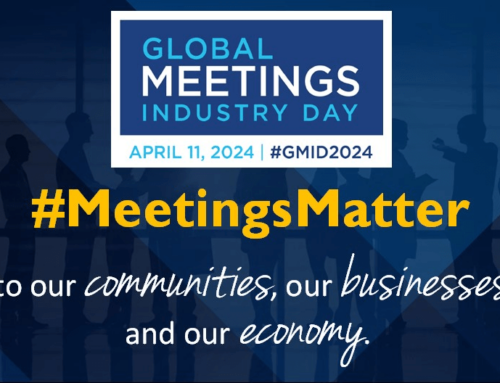Meetings are on the rise and are predicted to increase throughout the coming year in North America. According to a recent survey, global meeting spend is rising as well. Ninety percent of meetings will have an in-person component. (1) This is great news for meeting planners, but it will come with drawbacks.
There will be challenges to overcome in staffing and rising costs, however, if meeting planners understand how to overcome these issues they will be better positioned for effective in-person meetings. Here are five trends and challenges meeting planners should be aware of as they plan for 2023.
#1 Talent Challenges
The ever-changing U.S. labor market will continue to be problematic in 2023. With continued conversations about the possibility of a recession, conventional economic wisdom indicates staff scaling may be in order. Organizations that have an investment priority in the employee experience are carefully considering layoffs and the impact this will have on morale, company reputation, and long-term ability to attract talent.
Additionally, demand for workers will continue to outpace supply making it difficult for organizations to staff their companies. The few available workers are also demanding higher wages. To remain competitive, organizations must be proactive about their retention and acquisition strategies for 2023. Talent mobility (e.g., cross-training, retraining, upskilling) will be critical to dealing with labor challenges. (2)
Staffing has become a key issue as employees evaluate what they really want from their employment and life in general. Quiet quitting and the great resignation point to clues about what people want in a value-oriented workplace. The need for digital and technical skills continues to grow faster and faster, so current staff may need to be trained, retrained, or new talent brought in to accommodate the increased IT needs. At the same time, human skills are still mandatory for a worker to succeed in the meeting planning world. These highly sought interpersonal skills include creativity, critical thinking, interpersonal communication, leadership, caring, and compassion.
Contract or freelance talent should be part of labor acquisition planning and fulfillment strategies to avoid shortages and disruption and to fill gaps when needed. (3) Investing in employee experiences, and not just in other stakeholders (e.g., client/customer) experiences to retain and attract top and critical talent must remain a priority. (4)
#2 Inflation and Rising Costs
Inflation, labor shortages, increased travel costs, and supply chain issues are driving forces for cost containment. It’s estimated that in 2023 meeting costs will be twenty-five percent more than they were in 2019 due to these increased costs. (5) Meeting planners need to be “strategically creative,” using creativity and flexibility to effectively plan their meetings to contain cost challenges.
Here are some areas to consider when seeking to reduce costs:
- Learn when and how to use “the cost of status quo” and “sense of urgency” to inspire action. Change is ever present and when an economy is in fluctuation, this means that every moment matters. Processes and procedures that slow, stall or postpone decision-making today may mean a detriment in the future. Meeting planners should create of sense of urgency by defining what not acting today will cost in the future. This cost of not acting should consider future rising costs as well as missed opportunities and slowed company growth due to reduced employee motivation, productivity, effectiveness, etc.
PRO TIP:
-
- Utilize the lost opportunities and meeting ROI calculator to assist with arguing the status quo and sense of urgency needs.
- While it may be challenging to get specifics when initially looking at venues or gathering estimates, try to be as targeted as possible rather than give a broad range of requirements. This may be more difficult, especially with a fluctuating economy. However, the closer you can get to the exact needs, including having everything aligned with specific numbers (e.g., venue space, accommodation needs, food and beverage, transportation, travel, etc.), the more likely you will conserve costs in the future. Meeting planners may find it helpful to evaluate past events, generate pre-polling, or use other tools to refine early metrics and define meeting specifics.
- Explore options that might be outside of the specific, desired destination. It’s often possible to find a similar experience but at a more affordable location. Read how Gavel International reduced total costs by sixty percent here.
- Work with suppliers to reduce all overhead costs. Consider factors such as skilled versus outsourced labor, local vendors, what’s in season, etc.
- Consider what value you can offer suppliers. Long-term relationships are built on trust and solid relationships. If you are asking for a discount or negotiating a cost reduction, evaluate what’s in it for your suppliers. You’ll have more room to navigate if there’s something valuable you can offer to them besides just paying for the products/services they offer. For example, can you offer repeat business, a recognized brand recommendation for their website or social media, or a referral to another company that you know is needing the same products/services and is likely to buy?
- Avoid over-customization. This doesn’t mean you can’t have things customized, but it does mean that you should consider what is reasonable and what extra costs might be incurred, and how much overage or waste may be factored into prices. This customization savings benefit is especially true when it comes to food and beverage options.
PRO TIPS:
- Ask what the minimum spend is for food and beverage for the dates you need prior to negotiating. If that spend is out of budget, then it’s unlikely that this is the right venue option in the first place. However, if that spend already works within your budget, you’ll know if there’s room to negotiate.
- Cost savings can be found when utilizing items already within a standardized menu.
- Focus on quality over quantity. If you’re tight on budget, but desire excellent food and beverage experiences, cut back on a wide menu and invest in higher quality but fewer choices.
- Ask food and beverage vendors about large events that may be taking place during the same dates as your meeting. If buffet-style dining is an option, consider utilizing the same menu as other events occurring at the same time to help contain costs.
- Explore other creative options, if available, where portions can be more efficiently planned and better monitored during dining service. This can reduce shortages (not having enough of a popular item), overages (having too much food), and waste (food discarded by attendees). For example, family-style table service or on-demand buffet specialties such as crepes or omelets during breakfast.
#3 Supply Chain and Cost Containment Focused
As attendee numbers rise, internal team meetings/training, product launches, and small/simple meetings will increase significantly. (6) Managing spending (e.g., cost savings, cost containment, value-added services) is still a priority, and mitigating the potential risk of long-term planning (and risks associated with it) are now a leading factor since the pandemic.
Planning for and addressing issues with supply chain stability and insecurity is essential. This means investigating the entire supply chain and navigating the potential risks. (7) Meeting planners can assist in navigating this issue by working with local vendors who have less exposure within the supply chain (e.g., farm to table) or trusted vendor partners who have more transparency with their supply chain and have explored vulnerabilities to mitigate risks, reduce costs associated with inflation, etc.
PRO TIP:
- Read employee feedback from sites such as GlassDoor to learn more about how the vendor, as a company is managed. Are there issues with disgruntled or untrained employees that may impact service experiences? Are there problems with the supply chain, such as running out of products at critical times?
#4 Agile Security
Expect the unexpected. Agility and resilience are key factors. The ability to be prepared for, respond to, and recover from issues that may arise is essential for meeting planning and will continue into 2023. Relating to IT, Forrester predicts that eighty percent of companies will shift innovation spending from creativity to resilience. (8)
Health and safety – Meetings are already returning to models which closely resemble those prior to the pandemic. While health and safety will always be a top priority, the awareness of cleanliness, sanitation, ventilation, and foot traffic (e.g., lodging, food/beverage providers, meeting venue, etc.) will encourage more in-person activities. Meeting planners should continue to be informed about local, regional, and global risks that may impact in-person meetings. While the pandemic is over, meeting planners will continue to evolve and be ready to adapt to health and safety needs accordingly.
Data Privacy – Forrester predicts that “we will do less data collection and more listening” regarding privacy. The possibility of new privacy laws in 2023 is driving an increased interest in this trend. For instance, there are new laws that could come online in the U.S., and there may be enhancements to GDPR (General Data Protection Regulation) on the way. Meeting planners should consider what data is really necessary rather than collecting information just because it has been done a certain way in the past. Additionally, cookie laws and user tracking policies are changing. Meeting planners should work closely with both marketing and IT teams to understand the impact these changes can and will have in terms of website and app tracking even if meetings and events are for in-house activities.
#5 Sustainability Top-of-Mind
Sustainability, a “meeting that incorporates environmental considerations throughout all stages of the meeting to minimize a negative impact on the environment, ” is a top priority. Based on a 2022 survey, eighty percent of respondents indicate that their organization looks at sustainability when planning a meeting or event. But moving into 2023 and beyond, stakeholders expect organizations to take more action, especially concerning matters that impact greater society. (9)
Stakeholders want companies to measure their impact on the environment, society, and governance (ESG). Transparency, reporting, and accountability are part of this process. Every business needs a plan with clear goals and timeframes to reduce any adverse environmental impacts, and then the plan needs to have a solid action plan. This plan should include all vendors and the supply chain, which should also consider their ESG credentials. MeetingsNet recommends that companies evaluate their overall carbon footprint instead of carbon offsetting. (10)
Amid one of the most significant workplace disruptions, set against economic uncertainty, political instability, and eroding institutional trust, “My Employer” has emerged as an anchor of trust and stability. As today’s societal issues continue to mount, employees now see their workplace as a safe space and turn to it as a primary source of community. Many event planners believe that in 2023 social responsibility will be at the center of future events where the importance of creating a positive impact on the world is emphasized.
While trends are ever-evolving, it’s helpful to know that they exist and how to navigate challenges, as well as explore the opportunities created by trends. No one knows for certain what’s to come in the year ahead, but savvy, experienced meeting planners know how to create, manage, and execute successful meetings.
Looking for a polished meeting planner to set up your corporate meeting or event? Contact Gavel International for more information.
_____________________________
SOURCES:
- https://www.amexglobalbusinesstravel.com/meetings-events/meetings-forecast/
- https://remotoworkforce.com/2023-outlook-for-talent-supply-and-demand-in-the-us/
- https://www.forbes.com/sites/bernardmarr/2022/10/03/the-5-biggest-business-trends-for-2023/?sh=6a2016d14217
- https://www.informationweek.com/strategic-cio/what-to-expect-in-2023-it-spending-recession-talent-crisis-privacy
- https://www.businesstravelnews.com/Meetings/BCD-M-E-Rising-Mtg-Costs-Challenging-2023-Strategies
- https://www.hospitalitynet.org/opinion/4113108.html
- https://www.forbes.com/sites/bernardmarr/2022/10/03/the-5-biggest-business-trends-for-2023/?sh=6a2016d14217
- https://www.informationweek.com/strategic-cio/what-to-expect-in-2023-it-spending-recession-talent-crisis-privacy
- https://www.edelman.com/trust/2022-trust-barometer/special-report-trust-workplace
- https://www.meetingsnet.com/global-meetings/key-takeaways-bcd-me-s-2023-meetings-forecast#menu
- A Meeting Planner’s Guide to Using Drone Photography - April 15, 2024
- 11 Essential Items a Meeting Planner Must Have in an Event Kit - March 25, 2024
- Gavel International Joins in Global Meetings Industry Day 2024 (#GMID2024) Celebration - March 22, 2024







